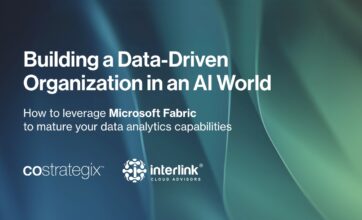4 Steps to Evolve Your Business Data Analytics
- 5 minutes read
If your organization is using data analytics to tell you only what has happened – you’re already behind. With the maturity of cloud architecture over the past few years, the value that data can offer has made evolutionary leaps. Today, businesses look at data not as a necessary cost to measure what has happened, but as a guide for predictive decision-making. The evolution of your business data analytics capabilities has become a critical element for revenue generation in today’s market.

If you’re not there yet, that’s ok. This article will walk you through the steps you can take over time to evolve the value you get from your data – and reduce the time it takes from when you collect data to when you’re able to apply insights to make a decision.
Evolving Your Data Analytics to Gain Value
Developing your business analytics capabilities is an evolution. Here are the four stages in the evolution of business data analytics that will help you transition from analyzing history to anticipating future trends.
Step 1: Descriptive Analysis
A Descriptive Analysis is the most basic of standard reports. This report answers the “what was” question: What was the revenue on a product last quarter? What was the number of surgeries performed by a doctor? You always need to start with descriptive reporting to tell you what happened. From these reports, companies can better understand what data they need to evolve along the analytics value chain to get closer to the point of action.
Step 2: Diagnostic Analysis
The next step in the evolution of data analytics is looking at your historic data to answer the question “why?”: Why did product revenue grow or shrink last quarter? Why did one doctor perform more surgeries than another? This usually involves bringing in additional intelligence and data sources from the business and examining cause-and-effect relationships.
Step 3: Predictive Analysis
In this step using Predictive Analysis, you apply machine learning and artificial intelligence (AI) tools to your data to anticipate what is likely to happen next. For example: Forecasting sales based on market trends or typical sales cycles; Applying consumer behavior patterns to personalize offers in order to upsell or cross-sell (i.e. items that are commonly purchased together); Looking at marketing trends to create optimal messaging around lifecycle events.
Step 4: Prescriptive Analysis
This is the highest level of the analytics value stream, Prescriptive Analytics is where there is little to no time between reporting and decision-making. In this stage, you look to data not just as a source for things that are going wrong, but also for prescriptive guidance about what to do about it. How often does someone bring a problem to you with no solution to fix it? Using prescriptive analysis, your data would provide guidance on what actions you could take to resolve an issue. For instance, if a prescriptive analysis of your data predicts an uptick in the sales of a particular item, it may recommend that you replenish quickly before that item goes out of stock; If your data shows market preference for one style over another, your prescriptive analysis may recommend changes to your supply chain so that you end up with less overstock. Being able to apply prescriptive guidance from your data brings immense competitive value to your organization and allows for logical and rapid decision making.
Before You Get Started: Become BI-Lingual
Business intelligence projects got a bad rap in the past. Lines were drawn between business analysts (the users of data) and data scientists (the compilers of data). Timelines were long. Sometimes months would go by between the request for data and the actual report, during which time many variables may have changed so the report missed the mark and went unused. It was hard to see the value of the investment.
Today, as enterprise-wide solutions demand collaboration between business and technology leaders, it’s important for your organization to become “BI-lingual.” Teams need to speak to both the technology and the business in order to translate current challenges and establish forward-thinking expectations for solutions that allow for growth. We can no longer look at data projects as strictly a technology problem, or a business problem. We can no longer afford to throw some requirements over a wall for IT to figure out.
As you look to make your organization more data mature and evolve your data analytics value, build teams that are centered around a deep understanding of “why” you are analyzing the data in the first place. Each member of the team will bring their expertise – system architecture, data governance, business analysis, data science, engineering. As long as you’re focused on a shared vision of “why,” your team will collaborate to ensure that decisions are not made in a vacuum and that each decision is informed by the business needs.
Thought Leadership and Partnership
It can be challenging to move up the data analytics value stream on your own. One of the best ways to progress, though, is to learn from the experience of others. CoStrategix is a technology solutions firm that partners with you to understand your short-term and long-term goals, develop the best data and analytics strategy to align with your business needs, and help you execute your projects in an agile format to help you see a return on your investment quickly. We bring experience in data modeling and applying ML and AI for both predictive and prescriptive analytics reporting. If you’re looking for an experienced partner to help you move up the data analytics value stream, we can help you.
AI Strategy & Solutions – Elevate your business with advanced analytics
Data & Insights – Drive insights that lead to competitive advantage
Product Development – Build platforms that power unique digital capabilities
Platform & Technology Modernization – Modernize for stellar experiences, efficiency, and AI
Related Blog Posts
4 Pitfalls to Avoid When Creating a Customer Journey Map
November 17, 2020
Composite AI: The Smarter Way to Navigate AI Complexity
March 4, 2025
Building a Data-Driven Organization for an AI World 2
February 5, 2025
Building a Data-Driven Organization for an AI World
February 4, 2025







